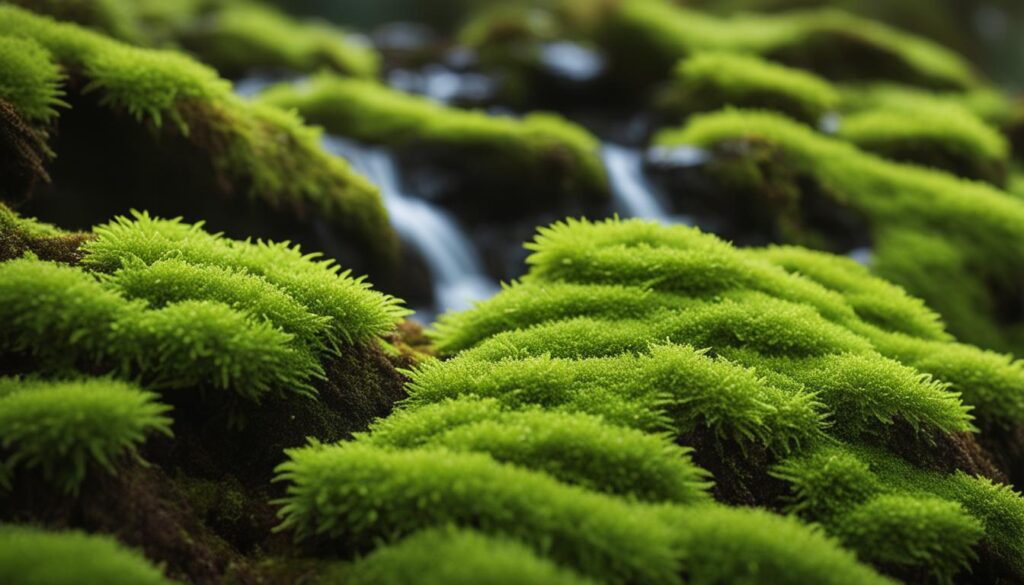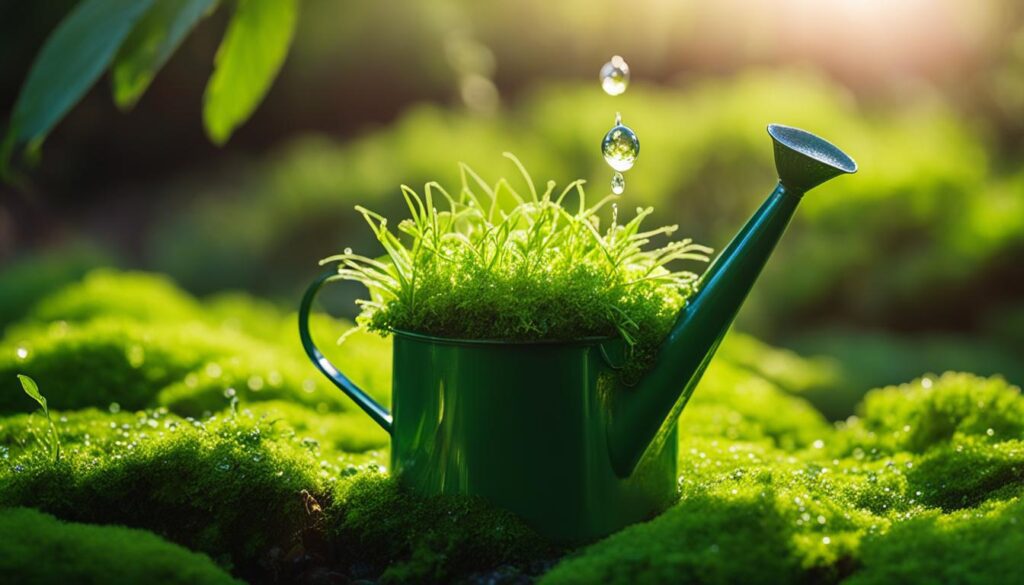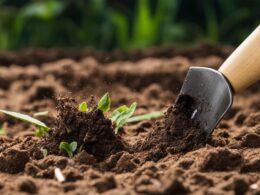Are you looking to add a touch of natural beauty to your garden? Consider moss gardening! Growing moss in your garden can create a lush and enchanting landscape that is both visually appealing and environmentally friendly. With just a few simple steps, you can cultivate your very own homegrown moss garden.
Key Takeaways
- Growing moss in your garden can add a touch of natural beauty and create a peaceful retreat.
- Moss gardens require minimal maintenance and are environmentally friendly.
- Mosses have unique characteristics, including reproduction methods and hardiness.
- Choosing the right location and preparing the yard are crucial for starting a successful moss garden.
- Caring for your moss lawn includes regular watering, weed control, and minimal foot traffic.
The Magic of Moss: A Closer Look at Moss Gardening
Annie Martin, the owner of Mountain Moss Enterprises, is a renowned moss expert in the field of moss gardening. With her extensive knowledge and expertise, Annie, also known as “Mossin’ Annie,” has dedicated herself to rescuing mosses from destruction and creating stunning moss gardens using innovative techniques and artistic approaches.
Through her book, “The Magical World of Moss Gardening,” Annie shares her passion for moss gardening and educates readers on the various cultivation techniques. Her book serves as a comprehensive guide, providing valuable insights into the enchanting world of moss and the benefits it brings to our gardens.
As the owner of Mountain Moss Enterprises, Annie’s business is licensed to harvest native mosses ethically, promoting sustainable practices. She is also certified to sell moss plants commercially, offering a range of carefully cultivated moss varieties that thrive in different environments.
With her expertise and creative talents, Annie encourages the joys of moss gardening and shares her knowledge with others. Whether you’re a seasoned gardener or a beginner, Mossin’ Annie’s moss cultivation techniques and artistic approach will inspire you to create your own magical moss garden.
The Fascinating Characteristics of Moss
Mosses, being non-vascular plants, have unique characteristics that set them apart from other plants. They do not have true leaves, branches, or roots but instead have threadlike structures called rhizoids.
Mosses reproduce through spores and can also grow from fragments of a plant, making them incredibly adaptable. This reproduction method allows moss to colonize various habitats and thrive in diverse environments.
Mosses demonstrate remarkable hardiness and can withstand a wide range of environmental conditions. They can survive sub-freezing temperatures and even catastrophic events, such as wildfires or floods. This hardiness makes moss an ideal plant for gardens in different regions, providing year-round greenery and resilience.
In addition to their adaptability, mosses are also self-sufficient. They obtain their nutrients and moisture from rainwater and the surrounding air. This characteristic makes them low-maintenance and an excellent choice for sustainable landscaping.
Another noteworthy feature of mosses is their efficiency in erosion control. Due to their dense growth and ability to retain moisture, mosses help stabilize soil and prevent erosion on slopes and bare areas.
Mosses also play a significant role in carbon sequestration. Through photosynthesis, they absorb carbon dioxide from the atmosphere and store carbon in their tissues, contributing to the reduction of greenhouse gas emissions and mitigating climate change.

Starting Your Moss Garden: Tips and Steps
Starting a moss garden is a simple process once you understand the conditions that moss requires for optimal growth. To ensure the success of your moss garden, follow these tips and steps:
1. Choose a Suitable Location
Moss thrives in moist and shady areas with compacted soil that has a slightly acidic pH. Before starting your moss garden, analyze your yard’s sun exposure, shade levels, and soil type. Determine the most suitable location where moss can thrive.
2. Enhance Moss Growth
If you already have moss growing in your yard, you can enhance its growth by providing additional acid or moisture. Moss prefers slightly acidic soil, so consider adding sulfur or peat moss to lower the pH. Maintaining proper moisture levels is also crucial for moss growth, especially during dry periods.
3. Transplant or Purchase Moss
To start your moss garden, you can either transplant moss from existing patches in your yard or purchase moss from a reputable supplier. Transplanting moss ensures that you have local species that are well-adapted to your climate. Alternatively, purchasing moss allows you to select specific varieties that suit your aesthetic preferences.
4. Prepare the Yard
Before planting moss, ensure that the chosen area is free from grass, weeds, and debris. Moss prefers a clean surface to establish itself properly. Remove any existing vegetation and clear the area of any unwanted materials to give your moss the best chance to thrive.
5. Plant the Moss
Once the yard is prepared, carefully place the transplanted or purchased moss onto the desired areas. Gently press the moss into the soil, ensuring good contact between the moss and the ground. Water the moss thoroughly after planting to help it establish and acclimate to its new surroundings.
6. Maintain and Monitor
Regularly monitor the moisture levels in your moss garden and ensure that the moss remains adequately hydrated. Avoid overwatering, as this can lead to moss rot. Periodically remove any fallen leaves or debris that may accumulate on the surface, as this can hinder moss growth and block sunlight.
Follow these steps and tips to start your own beautiful moss garden. With patience and proper care, you can create an enchanting green oasis in your own backyard. Happy moss gardening!
Caring for Your Moss Lawn
Moss lawns are low-maintenance and require minimal care once established. To ensure the continued growth and health of your moss lawn, there are a few key factors to consider: watering, weed control, and foot traffic.
Watering Moss
Regular watering is essential for the growth and vitality of moss, especially during the establishment phase. Keep the moss consistently moist by watering it gently, ensuring that the water reaches the root system. Avoid overwatering, as excessive moisture can lead to the growth of unwanted organisms.
Weed Control in Moss Lawn
It is important to prevent weed growth in your moss lawn to minimize competition and preserve the integrity of the moss. Hand removal is recommended as the safest method to eliminate weeds without damaging the delicate moss. Be cautious not to disturb the moss while removing weeds, as moss has a shallow root system.
Foot Traffic on Moss
Moss lawns can handle light foot traffic without significant damage, but excessive foot traffic can cause harm to the moss. If you anticipate frequent use of your moss lawn, consider adding stepping stones or pathways to protect the moss from heavy foot traffic. This will help distribute the weight and reduce direct impact on the moss.
Lastly, keeping your moss lawn free from leaves and debris will allow for proper photosynthesis and maintain the vibrant appearance of the moss. Regularly clearing any fallen leaves or twigs will ensure the moss can thrive and continue to add beauty to your landscape.
With these simple care practices, you can enjoy the natural beauty and low-maintenance appeal of a moss lawn.
The Advantages and Disadvantages of Moss Lawns
Moss lawns offer numerous benefits that make them an attractive alternative to traditional turfgrass lawns. Understanding the advantages and drawbacks of moss lawns can help you decide if they are the right choice for your outdoor space.
Benefits of Moss Lawns
- No Maintenance: Unlike traditional lawns, moss lawns require minimal maintenance. You don’t need to worry about irrigation, mowing, aeration, or dethatching.
- Poor Soil Adaptability: Moss thrives in compacted soil and can grow well even in poor soil conditions. This eliminates the need for fertilizers.
- No Pests: Moss lawns do not attract pests, reducing the need for pesticides or herbicides.
- Erosion Control: Moss lawns provide excellent erosion control, making them ideal for hillsides or areas prone to soil erosion.
- Eco-Friendly: Moss lawns are environmentally friendly because they require no chemical treatments. They contribute to a healthier ecosystem.
Drawbacks of Moss Lawns
- Heavy Foot Traffic: Moss lawns are not suitable for areas with heavy foot traffic. Excessive walking on moss can cause damage.
- Specific Conditions: Moss lawns require specific conditions, including shaded areas and acidic soil. Not all environments are suitable for moss growth.
- Weed Removal: Depending on the amount of sunshine the moss receives, it may develop areas with sparse coverage, and occasional manual weed removal may be necessary.
In conclusion, moss lawns offer several benefits, including low maintenance, adaptability to poor soil conditions, and eco-friendliness. They provide erosion control and do not attract pests. However, they may not be suitable for high-traffic areas and require specific growing conditions. Consider the advantages and disadvantages to decide if a moss lawn is the right choice for your garden.
Conclusion
Explore the wonders of moss gardening and transform your garden landscape into a serene and eco-friendly retreat. By following the steps and tips provided, you can create a beautiful and low-maintenance moss garden that offers both aesthetic appeal and environmental benefits. Moss gardens require minimal upkeep compared to traditional lawns, making them an ideal choice for busy garden enthusiasts.
One of the main advantages of moss gardens is their ability to provide efficient erosion control on hillsides, ensuring the protection and stability of your landscape. Additionally, mosses have a remarkable capability for carbon sequestration, contributing to the reduction of greenhouse gases in the atmosphere.
Creating your own moss retreat allows you to embrace the unique characteristics of mosses, such as their ability to thrive in shady and acidic soil conditions. The lush green carpets and velvety textures of mosses will bring tranquility and natural beauty to your outdoor space, creating a soothing ambiance for relaxation and contemplation.
So why wait? Start growing moss today and experience the magic of moss gardening. Enjoy the benefits of minimal maintenance, environmental sustainability, and the creation of a peaceful moss retreat in your very own backyard.
Can the Techniques for Growing Moss be Applied to Cultivating Plants in a Desert Climate?
Growing moss in a desert gardening in Las Vegas may be challenging, but the techniques involved can also be applied to cultivating plants in this climate. By creating microclimates, using shade structures, and amending the soil, it is possible to grow plants in the desert with the right approach and care.
FAQ
How do you grow moss in your garden?
To grow moss in your garden, you can start by analyzing your yard’s sun exposure, shade levels, and soil type to determine the most suitable location. Moss thrives in moist and shady areas with compacted soil that has a slightly acidic pH. You can enhance moss growth by providing additional acidity or moisture, transplanting moss from existing patches, or purchasing moss plants.
What are the characteristics of moss?
Mosses are non-vascular plants that lack true leaves, branches, or roots. They have threadlike structures called rhizoids. Mosses reproduce through spores and can also grow from fragments of a plant. They are hardy plants that can tolerate various environmental conditions, including sub-freezing temperatures. Mosses obtain their nutrients and moisture from rain and air, making them self-sufficient.
How do I start a moss garden?
To start a moss garden, you need to find a suitable location with the right conditions for moss growth. Analyze your yard’s shade levels, sun exposure, and soil type. If you already have moss growing in your yard, you can enhance its growth by providing additional acid or moisture. Transplanting moss from existing patches or purchasing moss can also be effective ways to start your moss garden.
How do I care for my moss lawn?
Caring for a moss lawn involves regular watering, especially during the establishment phase. Weed control is important to prevent competition with the moss, and hand removal is recommended to avoid damaging the moss. Moss lawns can handle light foot traffic, but excessive foot traffic can cause damage. Adding stepping stones can help protect the moss from heavy foot traffic. Keeping the lawn free from leaves and debris will ensure proper photosynthesis and maintain the moss’s vibrant appearance.
What are the advantages and disadvantages of moss lawns?
Moss lawns offer numerous advantages over traditional turfgrass lawns. They require less maintenance, including no need for irrigation, mowing, aeration, or dethatching. Moss lawns can grow well in poor soil conditions and eliminate the need for fertilizers. They also provide erosion control on hillsides and are eco-friendly, as they do not require herbicides or pesticides. However, moss lawns are not suitable for areas with heavy foot traffic, require specific conditions such as shaded and acidic soil, and may require manual weed removal.










